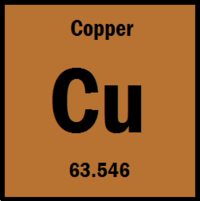Copper is a metallic element with the atomic number 29 and the scientific designation of Cu. The properties of copper make it highly ductile and conductive to both thermal and electrical attributes. It is also malleable and soft, while maintaining an orange-like coloring. Uses for copper primarily include its addition in alloys for building materials and electrical wiring.
The physical properties of copper make it react very profoundly with the air, most notably oxygen. This creates a thin layer of tarnish over the visible portion, giving copper its unique coloring. Pure copper with no exposure to the air maintains a pinkish color. This makes copper part of a small metallic family, with caesium and gold, which are not colored either silver or gray. Copper has the tendency to reflect light without the blue/violet spectrum, causing it to fall into the red scope of colors.
The atomic number is the number of protons in the nucleus of an atom. The number of protons define the identity of an element (i.e., an element with 6 protons is a carbon atom, no matter how many neutrons may be present). The number of protons determines how many electrons surround the nucleus, and it is the arrangement of these electrons that. Copper (atomic symbol: Cu, atomic number: 29) is a Block D, Group 11, Period 4 element with an atomic weight of 63.546. The number of electrons in each of copper's shells is 2, 8, 18, 1 and its electron configuration is Ar 3d 10 4s 1. The copper atom has a radius of 128 pm and a Van der Waals radius of 186 pm. Copper was first discovered.
Atomic Number Chart
- Like many of the transition elements, copper has a colored ion. Copper typically forms a bluish green solution. Copper (Cu) has two valences Cu I (cuprous) has one valence electron and Cu II (cupric) has two valence electrons. Copper was one of the earliest known metals, having reportedly been mined for.
- Atomic Number: 29: Atomic Mass: 63.546 atomic mass units: Number of Protons: 29: Number of Neutrons: 35: Number of Electrons: 29: Melting Point: 1083.0° C: Boiling Point: 2567.0° C. Copper beads dating back to 9000 B.C. Were found in Iraq: Common Compounds: Copper chloride (CuCl 2) Copper cyanide (CuCN).

Atomic Number Of Curium
Besides its solid state, copper can also exist in either a liquid or gaseous state. The properties of liquified copper make it appear green with no ambient light, while bright light makes it pink. When burnt into a gaseous state, copper gives off a black smoke, caused by its interaction with oxygen.

Atomic Number Of Compounds
One of the prevalent physical properties of copper is the fact that it fits in with silver and gold to compose Group 11 on the periodic table of the elements. Each of these elements forms metallic bonds that feature a single electron orbiting an electron shell on top of the nucleus. This causes Group 11 metals to all be malleable and conductive.
The chemical properties of copper include the tendency to cause galvanic corrosion. When copper is put in direct contact with certain metals such as iron, corrosion from water can occur to the other metal. The juncture between the metals acts as a battery and produces electrical currents. This is extremely important in the plumbing industry, where both copper and iron pipes are used to transfer water. To avoid this problem, the pipes are generally separated with a plastic or rubber fitting.
What Is The Electron Configuration Of Copper?The Atomic Number Of Copper Is 29. The Electronic Configuration Of Copper Can Be Written As [Ar]3d104s1. The Electronic Configuration Of Copper Doe...
One interesting property of copper is its naturally-occurring germicidal effect. Many pathogens are killed by any alloy containing more than 65 percent copper within a period of eight hours. Colder temperatures cause this time frame to be extended. This fact is highly useful in settings such as hospitals, which are responsible for many cases of acquired infections each year. By simply covering surfaces with copper alloys, the rate of infection can be decreased.




